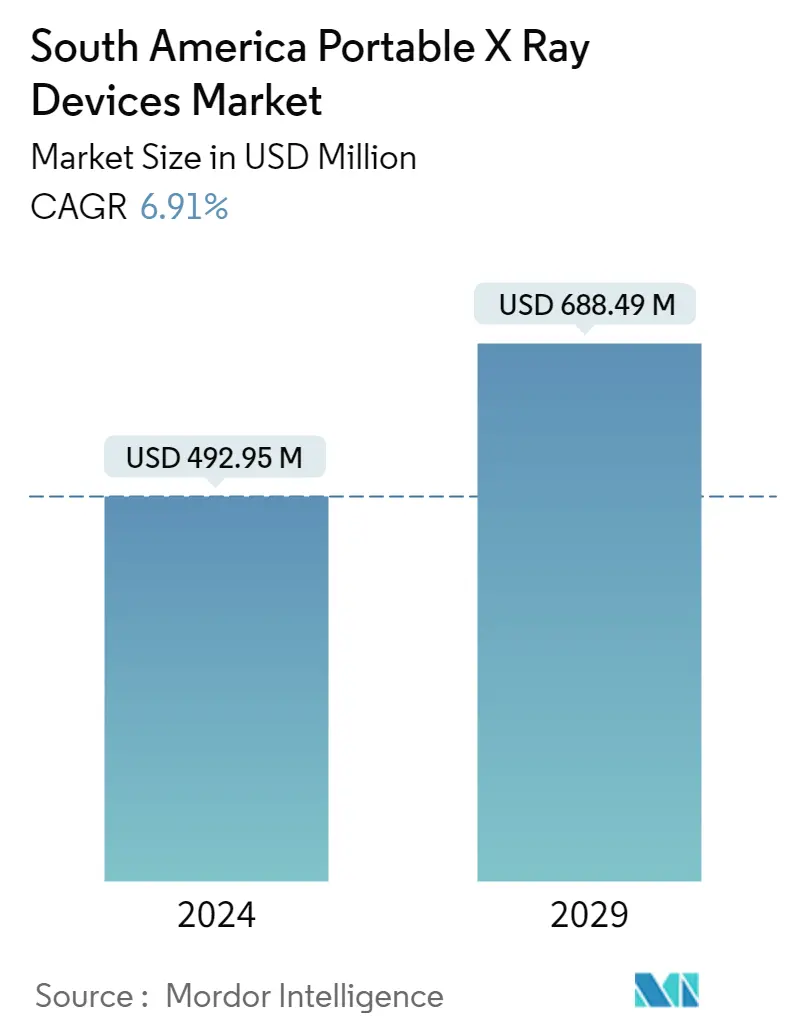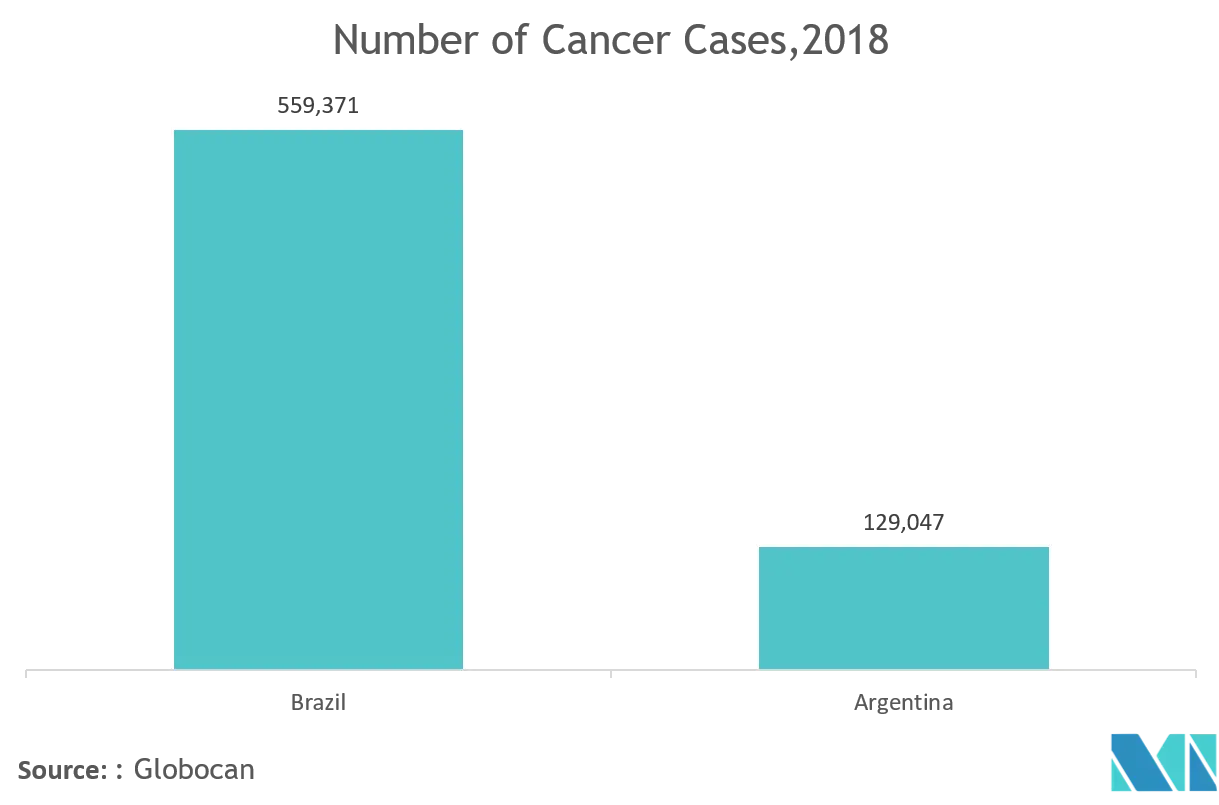South American Portable X Ray Devices Market Size

| Study Period | 2019 - 2029 |
| Base Year For Estimation | 2023 |
| Forecast Data Period | 2024 - 2029 |
| Market Size (2024) | USD 492.95 Million |
| Market Size (2029) | USD 688.49 Million |
| CAGR (2024 - 2029) | 6.91 % |
Major Players
*Disclaimer: Major Players sorted in no particular order |
Need a report that reflects how COVID-19 has impacted this market and its growth?
South American Portable X Ray Devices Market Analysis
The South America Portable X Ray Devices Market size is estimated at USD 492.95 million in 2024, and is expected to reach USD 688.49 million by 2029, growing at a CAGR of 6.91% during the forecast period (2024-2029).
In South American countries the geriatric population is rising which is driving the market growth. For instance, according to United Nations Department of Economic and Social Affairs, In Brazil there are around 19,526 population aged over 60 years in 2019. The number is estimated to reach 30,413 by 2030. The aging process is commonly associated with the onset of increased risks of chronic diseases and weakness in the bones and muscles.
In addition, Elderly patients face high risks of developing various disorders, such as orthopedic disorders, lung problems, and abdominal disorders. Thus, due to a rapid increase in the geriatric population, the prevalence of age-associated disorders has witnessed an increase, which, in turn, has resulted in the expansion of the market.
Furthermore, rising technological advancements and H]huge funding for R&D of portable technologies by private players and the governments is also propelling the overall market growth.
South American Portable X Ray Devices Market Trends
This section covers the major market trends shaping the South America Portable X-Ray Devices Market according to our research experts:
Digital X-ray is Expected to Hold the Largest Share of the Market in the Technology Segment
In the present scenario, the adoption rate of digital x-ray systems is not (or close to) 100%, in spite of their advantages over analog systems. However, this scenario is expected to change soon, and the x-ray devices market is likely to be almost completely dominated by digital x-ray systems in the future. Moreover, In March 2020, Seoul-based medical AI software company Lunit has announced the released AI-powered software for chest X-ray analysis to detect COVID-19. The software is being installed in one of the largest hospital networks in Brazil with 8 locations
Digital X-ray has the largest share in the South American market, owing to factors, such as its high patient throughput rates, fast image acquisition rates, good image quality, and low radiation risks.

South American Portable X Ray Devices Industry Overview
The South America Portable X Ray Devices Market is fragmented competitive and consists of several major players. In terms of market share, few of the major players are currently dominating the market. Some of the companies which are currently dominating the market are GE Healthcare, Koninklijke Philips NV, Canon Medical Systems, Envista Holdings Corporation(KaVo Dental GmbH), FUJIFILM Holdings America Corporation, Shimadzu Corporations, Siemens Healthcare, Varian Medical Systems Inc..
South American Portable X Ray Devices Market Leaders
GE Healthcare
Koninklijke Philips NV
Canon Medical Systems
FUJIFILM Holdings America Corporation
Envista Holdings Corporation((KaVo Dental GmbH)
*Disclaimer: Major Players sorted in no particular order

South American Portable X Ray Devices Market Report - Table of Contents
-
1. INTRODUCTION
-
1.1 Study Assumptions
-
1.2 Scope of the Study
-
-
2. RESEARCH METHODOLOGY
-
3. EXECUTIVE SUMMARY
-
4. MARKET DYNAMICS
-
4.1 Market Overview
-
4.2 Market Drivers
-
4.2.1 Growing Geriatric Population and Increasing Prevalence of Vascular Diseases
-
4.2.2 Huge Funding for R&D of Portable Technologies by Private Players and the Governments
-
-
4.3 Market Restraints
-
4.3.1 High Risk of Radiation Exposure
-
-
4.4 Porter's Five Force Analysis
-
4.4.1 Threat of New Entrants
-
4.4.2 Bargaining Power of Buyers/Consumers
-
4.4.3 Bargaining Power of Suppliers
-
4.4.4 Threat of Substitute Products
-
4.4.5 Intensity of Competitive Rivalry
-
-
-
5. MARKET SEGMENTATION
-
5.1 By Technology
-
5.1.1 Analog X-ray
-
5.1.2 Digital X-ray
-
-
5.2 By Application
-
5.2.1 Dental X-ray
-
5.2.2 Mammography
-
5.2.3 Chest X-ray
-
5.2.4 Abdomen X-ray
-
-
5.3 By Modality
-
5.3.1 Handheld X-ray Device
-
5.3.2 Mobile X-ray Devices
-
-
5.4 Geography
-
5.4.1 South America
-
5.4.1.1 Brazil
-
5.4.1.2 Argentina
-
5.4.1.3 Rest of South America
-
-
-
-
6. COMPETITIVE LANDSCAPE
-
6.1 Company Profiles
-
6.1.1 GE Healthcare
-
6.1.2 Koninklijke Philips NV
-
6.1.3 Canon Medical Systems
-
6.1.4 Danaher Corporation (KaVo Dental GmbH)
-
6.1.5 FUJIFILM Holdings America Corporation
-
6.1.6 Shimadzu Corporations
-
6.1.7 Siemens Healthcare
-
6.1.8 Varian Medical Systems Inc.
-
- *List Not Exhaustive
-
-
7. MARKET OPPORTUNITIES AND FUTURE TRENDS
South American Portable X Ray Devices Industry Segmentation
As per the scope of this report, a portable x-ray device is a wireless digital X-ray imaging device for mobile health providers such as doctors and first aid workers in field situations, during home care and in old age homes, as well as for medically oriented aid organizations, ships and offshore platforms. X-rays are a form of electromagnetic radiation of high energy and very short wavelength, which are able to pass through materials and solid objects, including the body.
South American Portable X Ray Devices Market Research FAQs
How big is the South America Portable X Ray Devices Market?
The South America Portable X Ray Devices Market size is expected to reach USD 492.95 million in 2024 and grow at a CAGR of 6.91% to reach USD 688.49 million by 2029.
What is the current South America Portable X Ray Devices Market size?
In 2024, the South America Portable X Ray Devices Market size is expected to reach USD 492.95 million.
Who are the key players in South America Portable X Ray Devices Market?
GE Healthcare, Koninklijke Philips NV, Canon Medical Systems, FUJIFILM Holdings America Corporation and Envista Holdings Corporation((KaVo Dental GmbH) are the major companies operating in the South America Portable X Ray Devices Market.
What years does this South America Portable X Ray Devices Market cover, and what was the market size in 2023?
In 2023, the South America Portable X Ray Devices Market size was estimated at USD 461.09 million. The report covers the South America Portable X Ray Devices Market historical market size for years: 2019, 2020, 2021, 2022 and 2023. The report also forecasts the South America Portable X Ray Devices Market size for years: 2024, 2025, 2026, 2027, 2028 and 2029.
South America Portable X-ray Devices Industry Report
Statistics for the 2024 South America Portable X-ray Devices market share, size and revenue growth rate, created by Mordor Intelligence™ Industry Reports. South America Portable X-ray Devices analysis includes a market forecast outlook to 2029 and historical overview. Get a sample of this industry analysis as a free report PDF download.
